#grand trunk railway
Photo

Belle Meade Farm, Bedford, Mass.
S. B. Elliot, 1906, The Shetland Pony: His Breeding, Care and Training
#Shetland pony#horses and ponies#Grand Trunk Railway#Belle Meade Farm#Massachusetts#1906#The Shetland Pony: His Breeding Care and Training
8 notes
·
View notes
Text

Grand Trunk Railway System.
#vintage illustration#vintage advertising#trains#railroads#railroad travel#train travel#grand trunk railway#grand trunk railroad
2 notes
·
View notes
Text

"RUSHING THE C. N. R. LINE FROM PEMBROKE," Ottawa Citizen. October 15, 1913. Page 1.
---
Contractor Expects Steel to be Laid to Portage Du Fort This Fall.
----
J. P. Mullarkey, contractor for the construction of the section of the Canadian Northern transcontinental railway between Ottawa and Pembroke, began to lay steel easterly from Pembroke two days ago. Before the severely cold weather comes, he says, he will have the steel laid as far as Portage du Fort, a distance of 27 miles.
Before the middle of next month the rails will be laid from Ottawa as far as Chats Falls. Then work on the construction of the two bridges over the Ottawa river, one at Portage du Fort and the other at Chats Falls, will be rushed so that the bridges will be completed early next spring.
The entire section of the road in question has been graded and it is planned to have it ready for operation in the fall of next year. The contractors on the sections from Pembroke to North Bay and from North Bay to the C. N. R. line now in operation from Fort William westward are making good headway with their work. Early in 1915, perhaps before then, the whole line from east to west will be ready for traffic.
The length of the C. N. R. route to Pembroke from Ottawa is 86 miles, 36 shorter than the C. P. R. and 22 shorter than the Grand Trunk.
#pembroke#ottawa#railway construction#laying track#canadian northern railway#grand trunk railway#transcontinental railroad#infrastructure construction
1 note
·
View note
Text
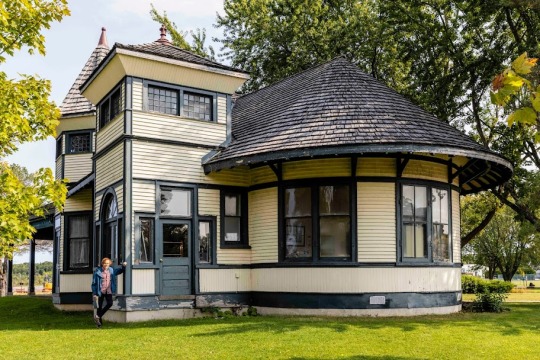
Wiarton's grand railway station is now preserved in Bluewater Park
#Wiarton#Grand Trunk Railway#Ontario#Queen Anne style#Victoriana#Canadian National Railway#Bluewater Park#CNR#Bruce County#railway station#heritage#nostalgia#history
6 notes
·
View notes
Photo
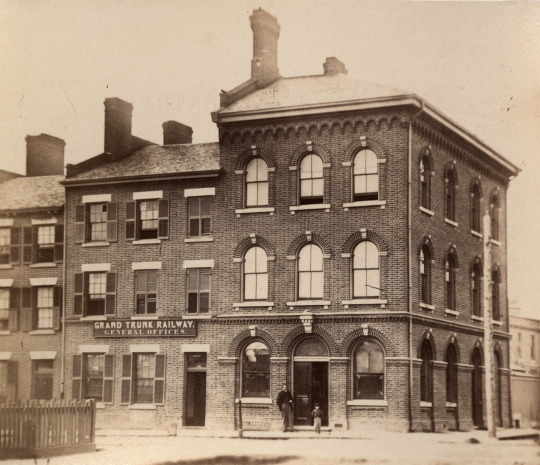
Toronto 1868
3 notes
·
View notes
Photo

Eight-wheeler locomotive 1008 was built at Kingston, Ontario, in 1910. When it was taken out of service in 1957 it was relocated to one of the last remaining stretches of original Grand Trunk Railway track at a site near Upper Canada Village.
4 notes
·
View notes
Photo

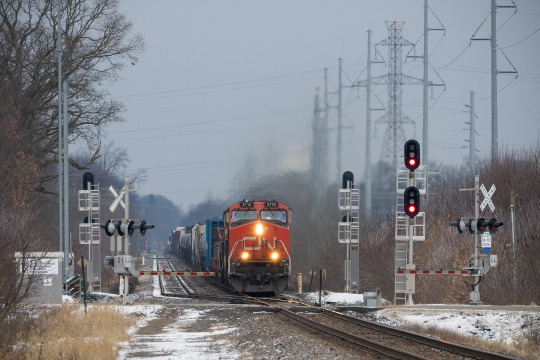




On the Grand Trunk
Here’s an eastbound train on the former Grand Trunk Railway, now Canadian National. The location is at Knight Street, east of Marcellus, Michigan, at milepost 138 (from Chicago). The second locomotive is interesting: a BC Rail GE C44-9WL, which is nearly 28 years old now. There was a DPU of the CN in this train as well.
Six images by Richard Koenig; taken January 21st 2023.
#railroadhistory#railwayhistory#canadiannational#grandtrunk#grandtrunkrailway#c44-9#c44-9wl#marcellusmi#telemash#telephoto#longlens
34 notes
·
View notes
Text
December 8th: in which Verne is bored and compares indigenous to animals twice
The train pursued its course, that evening, without interruption, passing Fort Saunders, crossing Cheyne Pass, and reaching Evans Pass. The road here attained the highest elevation of the journey, eight thousand and ninety-two feet above the level of the sea. The travellers had now only to descend to the Atlantic by limitless plains, levelled by nature. A branch of the “grand trunk” led off southward to Denver, the capital of Colorado. The country round about is rich in gold and silver, and more than fifty thousand inhabitants are already settled there.
Thirteen hundred and eighty-two miles had been passed over from San Francisco, in three days and three nights; four days and nights more would probably bring them to New York. Phileas Fogg was not as yet behind-hand.
During the night Camp Walbach was passed on the left; Lodge Pole Creek ran parallel with the road, marking the boundary between the territories of Wyoming and Colorado. They entered Nebraska at eleven, passed near Sedgwick, and touched at Julesburg, on the southern branch of the Platte River.
It was here that the Union Pacific Railroad was inaugurated on the 23rd of October, 1867, by the chief engineer, General Dodge. Two powerful locomotives, carrying nine cars of invited guests, amongst whom was Thomas C. Durant, vice-president of the road, stopped at this point; cheers were given, the Sioux and Pawnees performed an imitation Indian battle, fireworks were let off, and the first number of the Railway Pioneer was printed by a press brought on the train. Thus was celebrated the inauguration of this great railroad, a mighty instrument of progress and civilisation, thrown across the desert, and destined to link together cities and towns which do not yet exist. The whistle of the locomotive, more powerful than Amphion’s lyre, was about to bid them rise from American soil.
Fort McPherson was left behind at eight in the morning, and three hundred and fifty-seven miles had yet to be traversed before reaching Omaha. The road followed the capricious windings of the southern branch of the Platte River, on its left bank. At nine the train stopped at the important town of North Platte, built between the two arms of the river, which rejoin each other around it and form a single artery, a large tributary, whose waters empty into the Missouri a little above Omaha.
The one hundred and first meridian was passed.
Mr. Fogg and his partners had resumed their game; no one—not even the dummy—complained of the length of the trip. Fix had begun by winning several guineas, which he seemed likely to lose; but he showed himself a not less eager whist-player than Mr. Fogg. During the morning, chance distinctly favoured that gentleman. Trumps and honours were showered upon his hands.
Once, having resolved on a bold stroke, he was on the point of playing a spade, when a voice behind him said, “I should play a diamond.”
Mr. Fogg, Aouda, and Fix raised their heads, and beheld Colonel Proctor.
Stamp Proctor and Phileas Fogg recognised each other at once.
“Ah! it’s you, is it, Englishman?” cried the colonel; “it’s you who are going to play a spade!”
“And who plays it,” replied Phileas Fogg coolly, throwing down the ten of spades.
“Well, it pleases me to have it diamonds,” replied Colonel Proctor, in an insolent tone.
He made a movement as if to seize the card which had just been played, adding, “You don’t understand anything about whist.”
“Perhaps I do, as well as another,” said Phileas Fogg, rising.
“You have only to try, son of John Bull,” replied the colonel.
Aouda turned pale, and her blood ran cold. She seized Mr. Fogg’s arm and gently pulled him back. Passepartout was ready to pounce upon the American, who was staring insolently at his opponent. But Fix got up, and, going to Colonel Proctor said, “You forget that it is I with whom you have to deal, sir; for it was I whom you not only insulted, but struck!”
“Mr. Fix,” said Mr. Fogg, “pardon me, but this affair is mine, and mine only. The colonel has again insulted me, by insisting that I should not play a spade, and he shall give me satisfaction for it.”
“When and where you will,” replied the American, “and with whatever weapon you choose.”
Aouda in vain attempted to retain Mr. Fogg; as vainly did the detective endeavour to make the quarrel his. Passepartout wished to throw the colonel out of the window, but a sign from his master checked him. Phileas Fogg left the car, and the American followed him upon the platform. “Sir,” said Mr. Fogg to his adversary, “I am in a great hurry to get back to Europe, and any delay whatever will be greatly to my disadvantage.”
“Well, what’s that to me?” replied Colonel Proctor.
“Sir,” said Mr. Fogg, very politely, “after our meeting at San Francisco, I determined to return to America and find you as soon as I had completed the business which called me to England.”
“Really!”
“Will you appoint a meeting for six months hence?”
“Why not ten years hence?”
“I say six months,” returned Phileas Fogg; “and I shall be at the place of meeting promptly.”
“All this is an evasion,” cried Stamp Proctor. “Now or never!”
“Very good. You are going to New York?”
“No.”
“To Chicago?”
“No.”
“To Omaha?”
“What difference is it to you? Do you know Plum Creek?”
“No,” replied Mr. Fogg.
“It’s the next station. The train will be there in an hour, and will stop there ten minutes. In ten minutes several revolver-shots could be exchanged.”
“Very well,” said Mr. Fogg. “I will stop at Plum Creek.”
“And I guess you’ll stay there too,” added the American insolently.
“Who knows?” replied Mr. Fogg, returning to the car as coolly as usual. He began to reassure Aouda, telling her that blusterers were never to be feared, and begged Fix to be his second at the approaching duel, a request which the detective could not refuse. Mr. Fogg resumed the interrupted game with perfect calmness.
At eleven o’clock the locomotive’s whistle announced that they were approaching Plum Creek station. Mr. Fogg rose, and, followed by Fix, went out upon the platform. Passepartout accompanied him, carrying a pair of revolvers. Aouda remained in the car, as pale as death.
The door of the next car opened, and Colonel Proctor appeared on the platform, attended by a Yankee of his own stamp as his second. But just as the combatants were about to step from the train, the conductor hurried up, and shouted, “You can’t get off, gentlemen!”
“Why not?” asked the colonel.
“We are twenty minutes late, and we shall not stop.”
“But I am going to fight a duel with this gentleman.”
“I am sorry,” said the conductor; “but we shall be off at once. There’s the bell ringing now.”
The train started.
“I’m really very sorry, gentlemen,” said the conductor. “Under any other circumstances I should have been happy to oblige you. But, after all, as you have not had time to fight here, why not fight as we go along?”
“That wouldn’t be convenient, perhaps, for this gentleman,” said the colonel, in a jeering tone.
“It would be perfectly so,” replied Phileas Fogg.
“Well, we are really in America,” thought Passepartout, “and the conductor is a gentleman of the first order!”
So muttering, he followed his master.
The two combatants, their seconds, and the conductor passed through the cars to the rear of the train. The last car was only occupied by a dozen passengers, whom the conductor politely asked if they would not be so kind as to leave it vacant for a few moments, as two gentlemen had an affair of honour to settle. The passengers granted the request with alacrity, and straightway disappeared on the platform.
The car, which was some fifty feet long, was very convenient for their purpose. The adversaries might march on each other in the aisle, and fire at their ease. Never was duel more easily arranged. Mr. Fogg and Colonel Proctor, each provided with two six-barrelled revolvers, entered the car. The seconds, remaining outside, shut them in. They were to begin firing at the first whistle of the locomotive. After an interval of two minutes, what remained of the two gentlemen would be taken from the car.
Nothing could be more simple. Indeed, it was all so simple that Fix and Passepartout felt their hearts beating as if they would crack. They were listening for the whistle agreed upon, when suddenly savage cries resounded in the air, accompanied by reports which certainly did not issue from the car where the duellists were. The reports continued in front and the whole length of the train. Cries of terror proceeded from the interior of the cars.
Colonel Proctor and Mr. Fogg, revolvers in hand, hastily quitted their prison, and rushed forward where the noise was most clamorous. They then perceived that the train was attacked by a band of Sioux.
This was not the first attempt of these daring Indians, for more than once they had waylaid trains on the road. A hundred of them had, according to their habit, jumped upon the steps without stopping the train, with the ease of a clown mounting a horse at full gallop.
The Sioux were armed with guns, from which came the reports, to which the passengers, who were almost all armed, responded by revolver-shots.
The Indians had first mounted the engine, and half stunned the engineer and stoker with blows from their muskets. A Sioux chief, wishing to stop the train, but not knowing how to work the regulator, had opened wide instead of closing the steam-valve, and the locomotive was plunging forward with terrific velocity.
The Sioux had at the same time invaded the cars, skipping like enraged monkeys over the roofs, thrusting open the doors, and fighting hand to hand with the passengers. Penetrating the baggage-car, they pillaged it, throwing the trunks out of the train. The cries and shots were constant. The travellers defended themselves bravely; some of the cars were barricaded, and sustained a siege, like moving forts, carried along at a speed of a hundred miles an hour.
Aouda behaved courageously from the first. She defended herself like a true heroine with a revolver, which she shot through the broken windows whenever a savage made his appearance. Twenty Sioux had fallen mortally wounded to the ground, and the wheels crushed those who fell upon the rails as if they had been worms. Several passengers, shot or stunned, lay on the seats.
It was necessary to put an end to the struggle, which had lasted for ten minutes, and which would result in the triumph of the Sioux if the train was not stopped. Fort Kearney station, where there was a garrison, was only two miles distant; but, that once passed, the Sioux would be masters of the train between Fort Kearney and the station beyond.
The conductor was fighting beside Mr. Fogg, when he was shot and fell. At the same moment he cried, “Unless the train is stopped in five minutes, we are lost!”
“It shall be stopped,” said Phileas Fogg, preparing to rush from the car.
“Stay, monsieur,” cried Passepartout; “I will go.”
Mr. Fogg had not time to stop the brave fellow, who, opening a door unperceived by the Indians, succeeded in slipping under the car; and while the struggle continued and the balls whizzed across each other over his head, he made use of his old acrobatic experience, and with amazing agility worked his way under the cars, holding on to the chains, aiding himself by the brakes and edges of the sashes, creeping from one car to another with marvellous skill, and thus gaining the forward end of the train.
There, suspended by one hand between the baggage-car and the tender, with the other he loosened the safety chains; but, owing to the traction, he would never have succeeded in unscrewing the yoking-bar, had not a violent concussion jolted this bar out. The train, now detached from the engine, remained a little behind, whilst the locomotive rushed forward with increased speed.
Carried on by the force already acquired, the train still moved for several minutes; but the brakes were worked and at last they stopped, less than a hundred feet from Kearney station.
The soldiers of the fort, attracted by the shots, hurried up; the Sioux had not expected them, and decamped in a body before the train entirely stopped.
But when the passengers counted each other on the station platform several were found missing; among others the courageous Frenchman, whose devotion had just saved them.
Three passengers including Passepartout had disappeared. Had they been killed in the struggle? Were they taken prisoners by the Sioux? It was impossible to tell.
There were many wounded, but none mortally. Colonel Proctor was one of the most seriously hurt; he had fought bravely, and a ball had entered his groin. He was carried into the station with the other wounded passengers, to receive such attention as could be of avail.
Aouda was safe; and Phileas Fogg, who had been in the thickest of the fight, had not received a scratch. Fix was slightly wounded in the arm. But Passepartout was not to be found, and tears coursed down Aouda’s cheeks.
All the passengers had got out of the train, the wheels of which were stained with blood. From the tyres and spokes hung ragged pieces of flesh. As far as the eye could reach on the white plain behind, red trails were visible. The last Sioux were disappearing in the south, along the banks of Republican River.
Mr. Fogg, with folded arms, remained motionless. He had a serious decision to make. Aouda, standing near him, looked at him without speaking, and he understood her look. If his servant was a prisoner, ought he not to risk everything to rescue him from the Indians? “I will find him, living or dead,” said he quietly to Aouda.
“Ah, Mr.—Mr. Fogg!” cried she, clasping his hands and covering them with tears.
“Living,” added Mr. Fogg, “if we do not lose a moment.”
Phileas Fogg, by this resolution, inevitably sacrificed himself; he pronounced his own doom. The delay of a single day would make him lose the steamer at New York, and his bet would be certainly lost. But as he thought, “It is my duty,” he did not hesitate.
The commanding officer of Fort Kearney was there. A hundred of his soldiers had placed themselves in a position to defend the station, should the Sioux attack it.
“Sir,” said Mr. Fogg to the captain, “three passengers have disappeared.”
“Dead?” asked the captain.
“Dead or prisoners; that is the uncertainty which must be solved. Do you propose to pursue the Sioux?”
“That’s a serious thing to do, sir,” returned the captain. “These Indians may retreat beyond the Arkansas, and I cannot leave the fort unprotected.”
“The lives of three men are in question, sir,” said Phileas Fogg.
“Doubtless; but can I risk the lives of fifty men to save three?”
“I don’t know whether you can, sir; but you ought to do so.”
“Nobody here,” returned the other, “has a right to teach me my duty.”
“Very well,” said Mr. Fogg, coldly. “I will go alone.”
“You, sir!” cried Fix, coming up; “you go alone in pursuit of the Indians?”
“Would you have me leave this poor fellow to perish—him to whom every one present owes his life? I shall go.”
“No, sir, you shall not go alone,” cried the captain, touched in spite of himself. “No! you are a brave man. Thirty volunteers!” he added, turning to the soldiers.
The whole company started forward at once. The captain had only to pick his men. Thirty were chosen, and an old sergeant placed at their head.
“Thanks, captain,” said Mr. Fogg.
“Will you let me go with you?” asked Fix.
“Do as you please, sir. But if you wish to do me a favour, you will remain with Aouda. In case anything should happen to me—”
A sudden pallor overspread the detective’s face. Separate himself from the man whom he had so persistently followed step by step! Leave him to wander about in this desert! Fix gazed attentively at Mr. Fogg, and, despite his suspicions and of the struggle which was going on within him, he lowered his eyes before that calm and frank look.
“I will stay,” said he.
A few moments after, Mr. Fogg pressed the young woman’s hand, and, having confided to her his precious carpet-bag, went off with the sergeant and his little squad. But, before going, he had said to the soldiers, “My friends, I will divide five thousand dollars among you, if we save the prisoners.”
It was then a little past noon.
Aouda retired to a waiting-room, and there she waited alone, thinking of the simple and noble generosity, the tranquil courage of Phileas Fogg. He had sacrificed his fortune, and was now risking his life, all without hesitation, from duty, in silence.
Fix did not have the same thoughts, and could scarcely conceal his agitation. He walked feverishly up and down the platform, but soon resumed his outward composure. He now saw the folly of which he had been guilty in letting Fogg go alone. What! This man, whom he had just followed around the world, was permitted now to separate himself from him! He began to accuse and abuse himself, and, as if he were director of police, administered to himself a sound lecture for his greenness.
“I have been an idiot!” he thought, “and this man will see it. He has gone, and won’t come back! But how is it that I, Fix, who have in my pocket a warrant for his arrest, have been so fascinated by him? Decidedly, I am nothing but an ass!”
So reasoned the detective, while the hours crept by all too slowly. He did not know what to do. Sometimes he was tempted to tell Aouda all; but he could not doubt how the young woman would receive his confidences. What course should he take? He thought of pursuing Fogg across the vast white plains; it did not seem impossible that he might overtake him. Footsteps were easily printed on the snow! But soon, under a new sheet, every imprint would be effaced.
Fix became discouraged. He felt a sort of insurmountable longing to abandon the game altogether. He could now leave Fort Kearney station, and pursue his journey homeward in peace.
Towards two o’clock in the afternoon, while it was snowing hard, long whistles were heard approaching from the east. A great shadow, preceded by a wild light, slowly advanced, appearing still larger through the mist, which gave it a fantastic aspect. No train was expected from the east, neither had there been time for the succour asked for by telegraph to arrive; the train from Omaha to San Francisco was not due till the next day. The mystery was soon explained.
The locomotive, which was slowly approaching with deafening whistles, was that which, having been detached from the train, had continued its route with such terrific rapidity, carrying off the unconscious engineer and stoker. It had run several miles, when, the fire becoming low for want of fuel, the steam had slackened; and it had finally stopped an hour after, some twenty miles beyond Fort Kearney. Neither the engineer nor the stoker was dead, and, after remaining for some time in their swoon, had come to themselves. The train had then stopped. The engineer, when he found himself in the desert, and the locomotive without cars, understood what had happened. He could not imagine how the locomotive had become separated from the train; but he did not doubt that the train left behind was in distress.
He did not hesitate what to do. It would be prudent to continue on to Omaha, for it would be dangerous to return to the train, which the Indians might still be engaged in pillaging. Nevertheless, he began to rebuild the fire in the furnace; the pressure again mounted, and the locomotive returned, running backwards to Fort Kearney. This it was which was whistling in the mist.
The travellers were glad to see the locomotive resume its place at the head of the train. They could now continue the journey so terribly interrupted.
Aouda, on seeing the locomotive come up, hurried out of the station, and asked the conductor, “Are you going to start?”
“At once, madam.”
“But the prisoners, our unfortunate fellow-travellers—”
“I cannot interrupt the trip,” replied the conductor. “We are already three hours behind time.”
“And when will another train pass here from San Francisco?”
“To-morrow evening, madam.”
“To-morrow evening! But then it will be too late! We must wait—”
“It is impossible,” responded the conductor. “If you wish to go, please get in.”
“I will not go,” said Aouda.
Fix had heard this conversation. A little while before, when there was no prospect of proceeding on the journey, he had made up his mind to leave Fort Kearney; but now that the train was there, ready to start, and he had only to take his seat in the car, an irresistible influence held him back. The station platform burned his feet, and he could not stir. The conflict in his mind again began; anger and failure stifled him. He wished to struggle on to the end.
Meanwhile the passengers and some of the wounded, among them Colonel Proctor, whose injuries were serious, had taken their places in the train. The buzzing of the over-heated boiler was heard, and the steam was escaping from the valves. The engineer whistled, the train started, and soon disappeared, mingling its white smoke with the eddies of the densely falling snow.
The detective had remained behind.
Several hours passed. The weather was dismal, and it was very cold. Fix sat motionless on a bench in the station; he might have been thought asleep. Aouda, despite the storm, kept coming out of the waiting-room, going to the end of the platform, and peering through the tempest of snow, as if to pierce the mist which narrowed the horizon around her, and to hear, if possible, some welcome sound. She heard and saw nothing. Then she would return, chilled through, to issue out again after the lapse of a few moments, but always in vain.
Evening came, and the little band had not returned. Where could they be? Had they found the Indians, and were they having a conflict with them, or were they still wandering amid the mist? The commander of the fort was anxious, though he tried to conceal his apprehensions. As night approached, the snow fell less plentifully, but it became intensely cold. Absolute silence rested on the plains. Neither flight of bird nor passing of beast troubled the perfect calm.
21 notes
·
View notes
Text
What-If: American Railroads — Section 2: Railroads Absorbed (part 1)
With my alternate history on American railroads, one major part of it is that President Dwight D. Eisenhower would pass a Staggers Act of 1955, which would allow railroads to innovate and expand their operations and provide healthy competition with not only other railroads, but also cars and planes. While the big railroads (like New York Central and Chesapeake & Ohio) would greatly benefit from this, the smaller railroads (like New Haven or Western Pacific) wouldn’t be as lucky… but the smaller railroads’ territories would not go to waste as from the late 1950s to the early 1970s, the bigger railroads would absorb the smaller ones. And the smaller railroads absorbed by the bigger ones will be shown below with the big railroads’ logos being above a collection of maps of the smaller railroads.



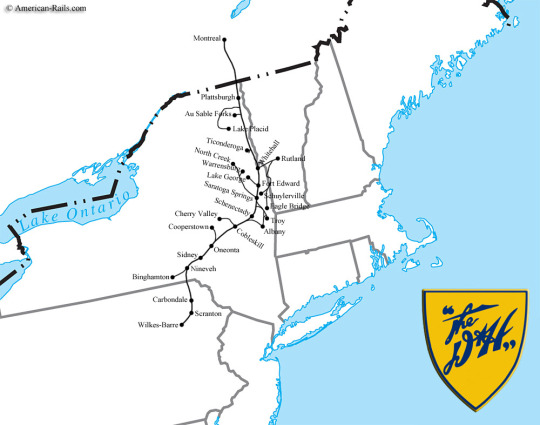
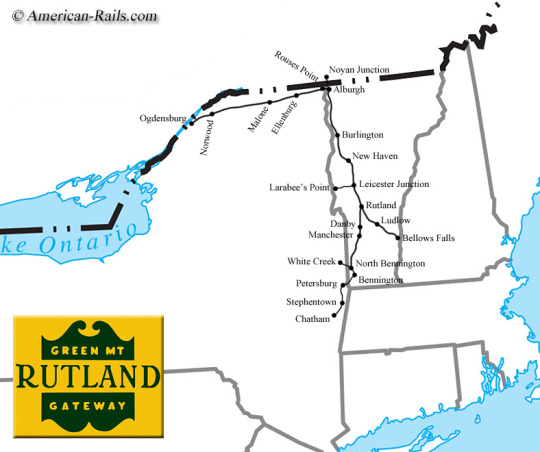



A. New York Central ⬆️.
Boston and Maine
New Haven
Delaware and Hudson
Rutland Railroad
Bangor and Aroostook Railroad
Central Vermont
Maine Central


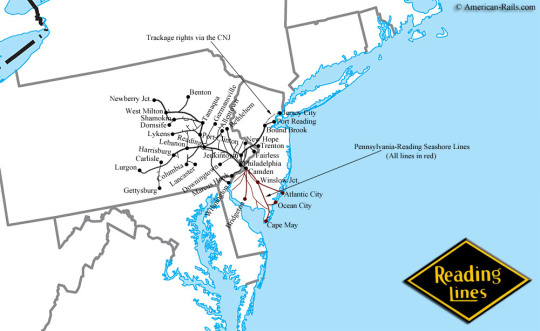
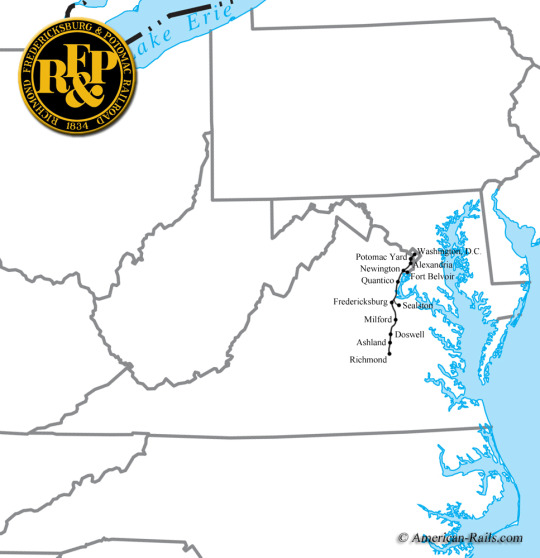
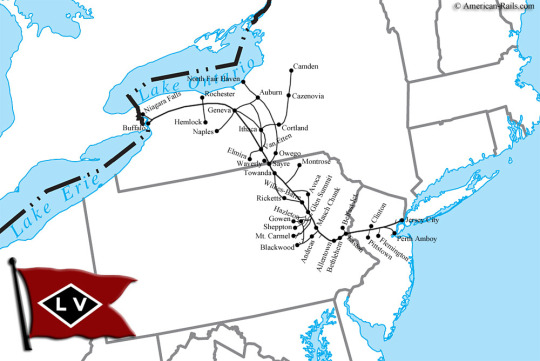
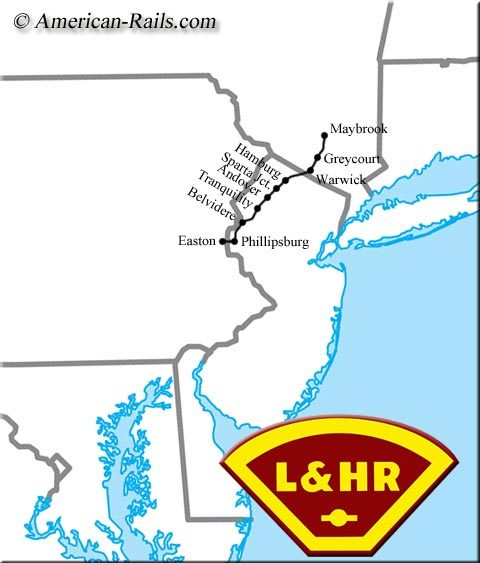

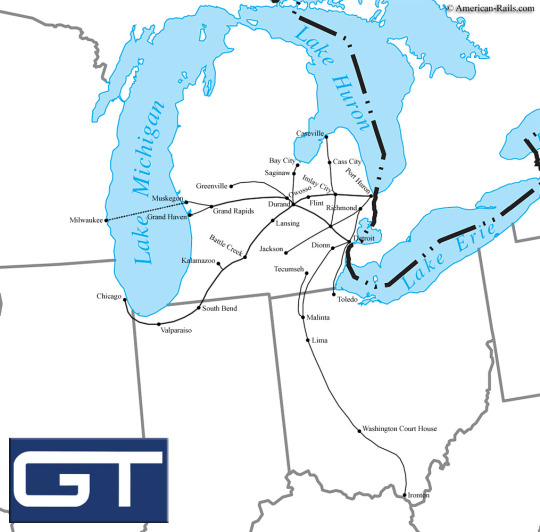

B. Pennsylvania Railroad ⬆️
Lehigh New England
Reading Lines/Railroad
Richmond, Fredericksburg and Potomac
Lehigh Valley
Lehigh and Hudson River
Central Railroad of New Jersey
Grand Trunk Western
Pennsylvania-Reading Seashore Lines



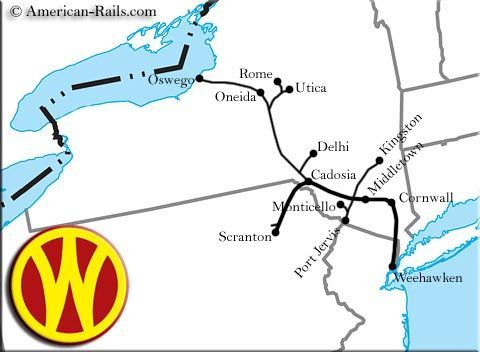
C. Chesapeake and Ohio ⬆️
Erie Railroad
Lackawanna Railroad
New York, Ontario and Western Railway

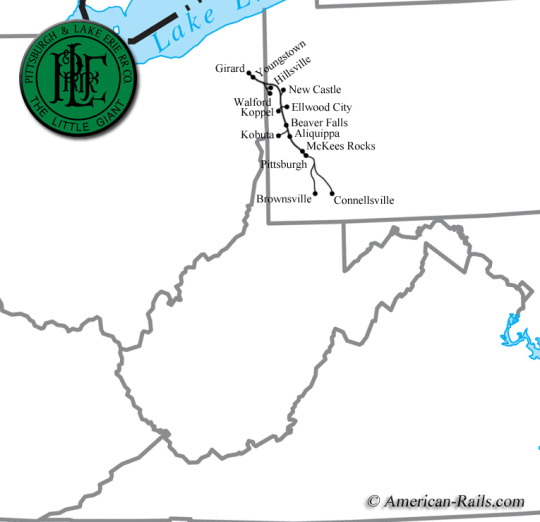
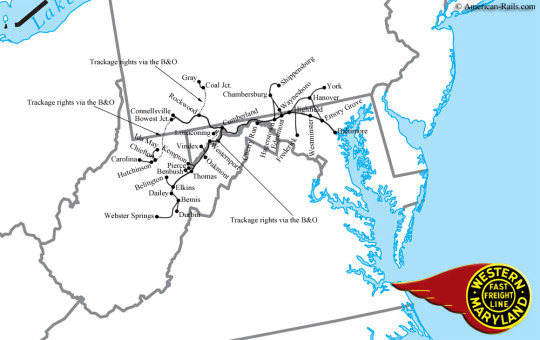


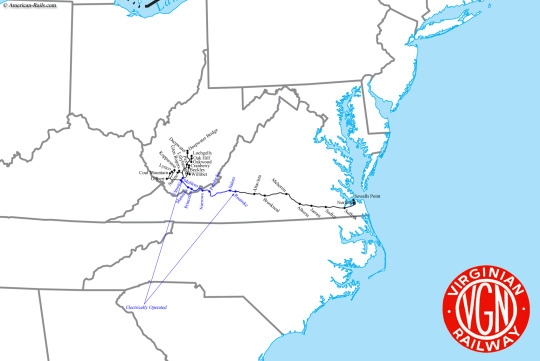
D. Baltimore and Ohio ⬆️
Pittsburgh and Lake Erie
Western Maryland
Wabash
Ann Arbor
Virginian Railway



E. Norfolk and Western ⬆️
Nickel Plate Road
(original) Norfolk Southern
#history#railroad#railroads#railway#railways#new york central#pennsylvania railroad#chesapeake & ohio#baltimore & ohio#norfolk and western#alternate history
2 notes
·
View notes
Photo

MWW Artwork of the Day (11/25/22)
Frank Brangwyn (Welsh, 1867-1956)
Charity (1900)
Oil on canvas, 147.3 x 160 cm.
National Gallery of Canada, Ottawa
A painter and graphic artist, Brangwyn studied at South Kensington Art School and worked as a draughtsman for the British designer William Morris between 1882 and 1884. In 1895 Siegfried Bing commissioned him to paint a mural for the "Art Nouveau" boutique in Paris. Brangwyn's style reflects the rhythmic, decorative line favoured by Art Nouveau, while retaining the Symbolist influence of Edward Burne-Jones and the Pre-Raphaelites. His frieze for the ticket hall of the Canadian Grand Trunk Railway office in London, England, completed in 1908, can now be seen in the Ottawa Conference Centre.
21 notes
·
View notes
Photo

this is a temporary bio for jasper since I don’t have access to the original templates I made and I haven’t gotten the guts to try to rescue them yet; there’s still some decisions (like a full human name for instance) that I have to make before I would properly type this up too. I just wanted to finish the art though since I wanted to have a coloured ref up somewhere.
Notes:
Jasper’s “key shape” is triangle. The 90s snowboarder outfits tend to reverse their silhouette a little bit but imagine a bit of an hourglass shape with very buff shoulders, thick soft chest, etc. Lots of visible back muscles. Generally, they are a little more angular than Eleanor.
Their necklace is a jasper stone but it’s actually not something that really occurs in the area, you’re more likely to find jade locally.
Once again the flag is heavily censored because i find the text so cringeworthy lol
Transcription below
Jasper
Region: West (Rockies)
Population: ~5,000+
Founded: 1813
Incorporated: 1995, 2001
Other: Largest Nat’l park in Rockies, UNESCO site
Character
Human Name: Jasper (TBD) (they/them)*
“B-Day”: August 31
Heritage: Metis [Beaver? Cree? + French? Scottish?]
Height: 6′1″
Hair: Black
Eyes: Hazel (more green)
MBTI: INFP?
* doesn’t really care tho
Symbols
Jasper Park Lodge, Pyramid Mountain, Jasper the Bear
Bio
- Founded as NWC / HBC fur trade post that fell into disuse and was abandoned
- Moved to present site with Grand Trunk + CN railways at the centre of the Jasper Forest Reserve (later Jasper National Park)
- Known for cozy cabin culture, laid back and chill but black diamond skills
#projectcanada cities#pc: jasper#hapo art#digital art#clip studio paint#battle ref#hetalia oc#hws oc#jasper has a name
22 notes
·
View notes
Text

Onto a more positive note on Zachery, he absolutely loves railroads and trains (and he has since he was a toddler). And he has a lot of knowledge about trains and many railroad companies in America. And he has a selection of railroads in his top 11 and secondary 12. Zachery’s top 11 railroads are… New York Central System, Pennsylvania Railroad, Chesapeake & Ohio, Baltimore & Ohio, Union Pacific, Norfolk & Western, The Milwaukee Road, Burlington Route, Souther Pacific, Santa Fe, and Chicago & NorthWestern… and Zachery’s secondary 12 railroads are… New Haven, Southern Railway, Northern Pacific, Great Northern, Seaboard Air Line Railroad, Virginian Railway, Erie Railroad, Western Pacific, Rock Island Railroad, Lackawanna Railroad, Illinois Central, and Grand Trunk Western.
2 notes
·
View notes
Video
In and Out of the Sun
A pair of L&N GP38-2's approach Hayford Crossing with the Grand Trunk Western in Chicago in February 1978. The train is on the Belt Railway of Chicago with a transfer run from the old Monon in South Hammond to BRC's Clearing yard.
9 notes
·
View notes
Photo

“For the Titanic’s Brave Dead,” Toronto Globe. April 24, 1912. Page 1.
----
NOT FOR THESE ALONE, BUT FOR THE LIVING, ALSO, WHOSE BRAVE ENDEAVORS MAKE THAT SACRIFICE WORTH WHILE
----
A news despatch says that at 11.30 (Montreal time) on Thursday morning there will be an absolute cessation of work in every department of the Grand Trunk and Grand Trunk Pacific Railways in Canada, Britain and the United States, in memory of the late President G. M. Hays [who died on the Titanic.]
#hms titanic#sinking of the titanic#maritime disaster#moment of silence#railway workers#grand trunk railway#grand trunk pacific railway#railway capitalism#for the honoured dead#in memoriam
1 note
·
View note
Photo

Following it's life after the Iron Horse Rambles, Reading 2102 would still take part in numerous excursions. Of these which was a doubleheader with Cuyahoga Valley Scenic Railroad (Ex Grand Trunk Western) 4070, an S3A class 2-8-2 USRA Light Mikado built by ALCO in December 1918. Unfortunately, the trip was ill-fated as the 4070 threw an eccentric rod on the Horseshoe Curve stalling busy rail traffic resulting in Conrail to ban steam operations for several years. Today, 2102 now operates on the Reading and Northern Railroad while 4070 is still currently under restoration at the Midwest Railway Preservation Society.
Models and Route by: K&L Trainz, Canadian Pacific Locomotive Works, Jointed Rail, Auran, and Download Station
#RDG#Reading#Reading Company#2102#RDG 2102#Reading 2102#GTW#GTW 4070#4070#Grand Trunk Western#Grand Trunk Western 4070#Steam Locomotives#Trains#Trainz Simulator
2 notes
·
View notes
Text

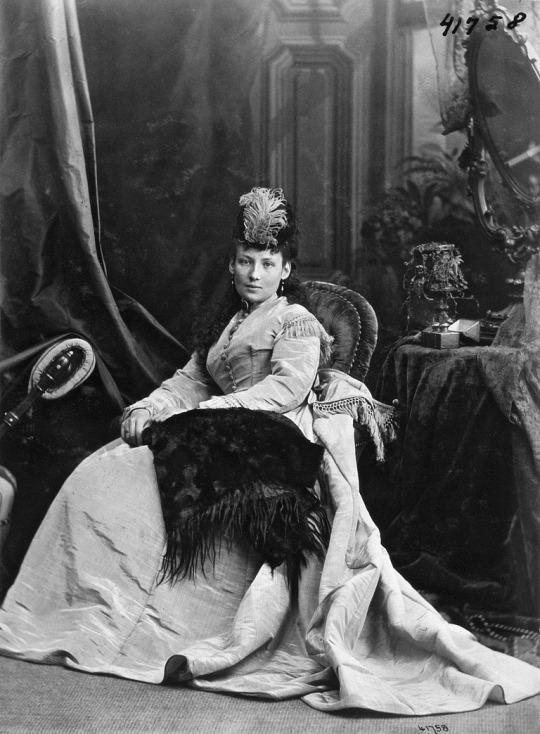

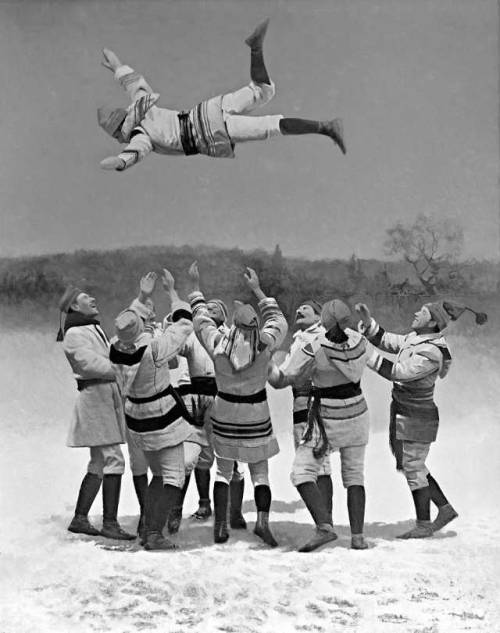
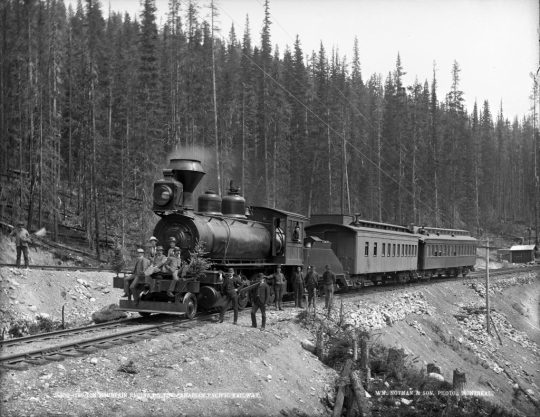
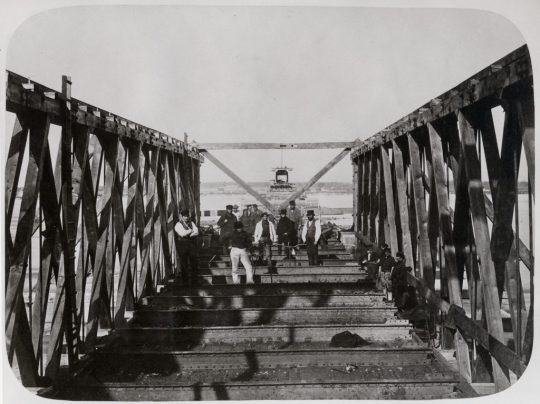
William Notman the pioneering Scottish photographer was born on in Paisley March 8th 1826.
WIlliam Notman photographed upper-class men and women in rich surroundings, but also too pictures of ordinary people, nature and the construction of Montreal's Victoria Bridge.
Notman was born and raised in Paisley where he received a decent education, which included lessons in painting and drawing.. After leaving school worked in a family firm but when it ran into financial difficulties Notman hoped to pursue a career as a professional artist. His hopes were thwarted by the expectation that he would join his father’s cloth design and manufacturing business. As it turned out, however, during a severe economic downturn, Notman fabricated client orders in order to pay down mounting debts. Fraud charges were then laid, and in 1856 he fled Glasgow for Montréal in part so that responsibility for the fraud could be laid on him and the rest of the family could avoid prosecution.
An amateur photographer, he quickly established a flourishing professional photography studio on Bleury Street,kn the city, a location close to Montreal's central commercial district, where he attracted clients who were members of the political and business elite.
His techniques predated Photoshop by about a century, but just because we can achieve in a few clicks what would have taken William Notman days of painstaking photography, painting, and literal cutting and pasting, should make his legacy more impressive, not less.
In 1858, he was commissioned by the Grand Trunk Railway to photograph the construction of Montréal's remarkable Victoria Bridge. Notman gave the Prince of Wales a maple box containing an image he had taken of the construction of the bridge as well as scenes from eastern and western Canada, which were apparently eventually shown to great acclaim to Queen Victoria.
You would imagine his studio would have been a small business, due to the era, but no, Notman's staff was some 55 strong in the 1870s) and included apprentice photographers.
He established 14 branch studios in eastern Canada and the United States, all managed by his trainees. Notman won many medals for his work in exhibitions at home and abroad. To meet the demand for landscapes and other views, he sent his photographers across Canada, recording the construction of the Canadian Pacific Railway, the rise of the western cities, the life of the plains and coastal Aboriginal peoples, the lumber trade of the Ottawa Valley, East Coast fishing, rural activities and the bustle of the cities.
Notman also became famous for the composite photographs of the snowshoe and curling clubs produced by his studio. These large creations were made up of 300 or more individual photographs, cut out and pasted onto a painted background, the first cut and pasting perhaps!?
Always community minded, Notman was involved in art associations, church societies, sports clubs and other Montréal organizations. He was also a backer of the Windsor Hotel and copartner in large holdings in Longueuil, where he had a summer home. Of his seven children, all three boys became photographers. William McFarlane Notman, his eldest son, took over the business at his death. The Notman collection, containing over 400,000 photographs, plus office records and family correspondence, forms part of the collections of the Notman Photographic Archives housed in the McCord Museum of McGill University.
When William Notman died suddenly in November 1891 after a short bout of pneumonia, management of the studio Wm Notman & Son was left to his son William McFarlane Notman, an experienced photographer in his own right
In 1957, the Notman Collection was purchased by McGill University. The 200,000 negatives, 43 Index Books, 200 Picture Books and assorted memorabilia were transferred to the McCord Museum of Canadian History.
6 notes
·
View notes
